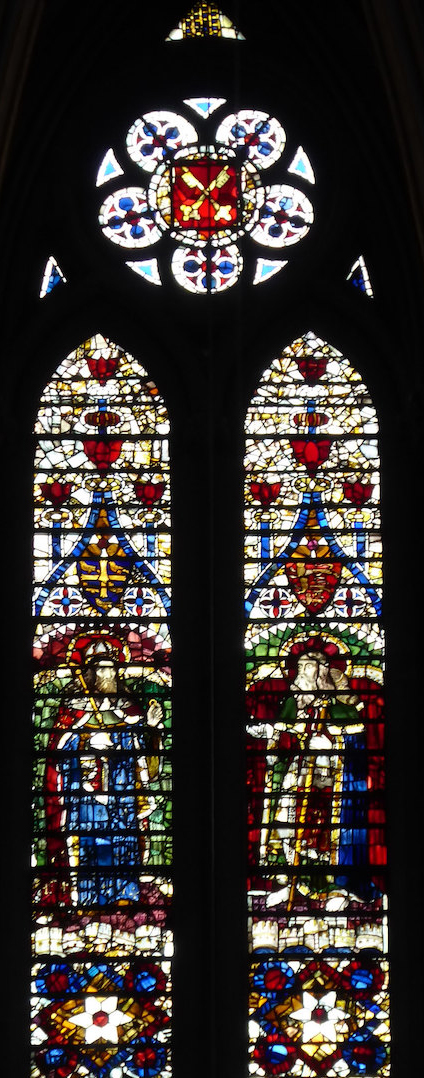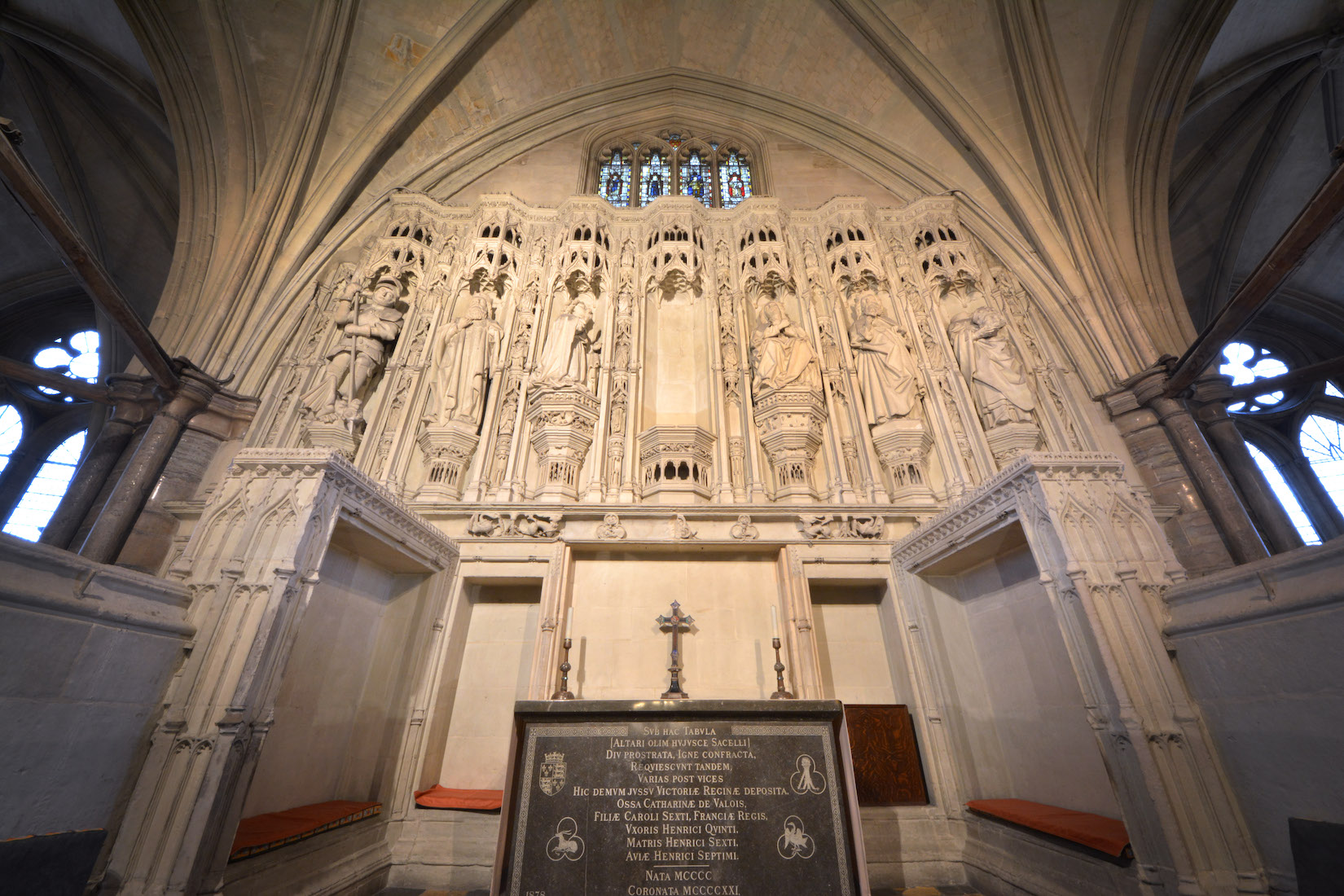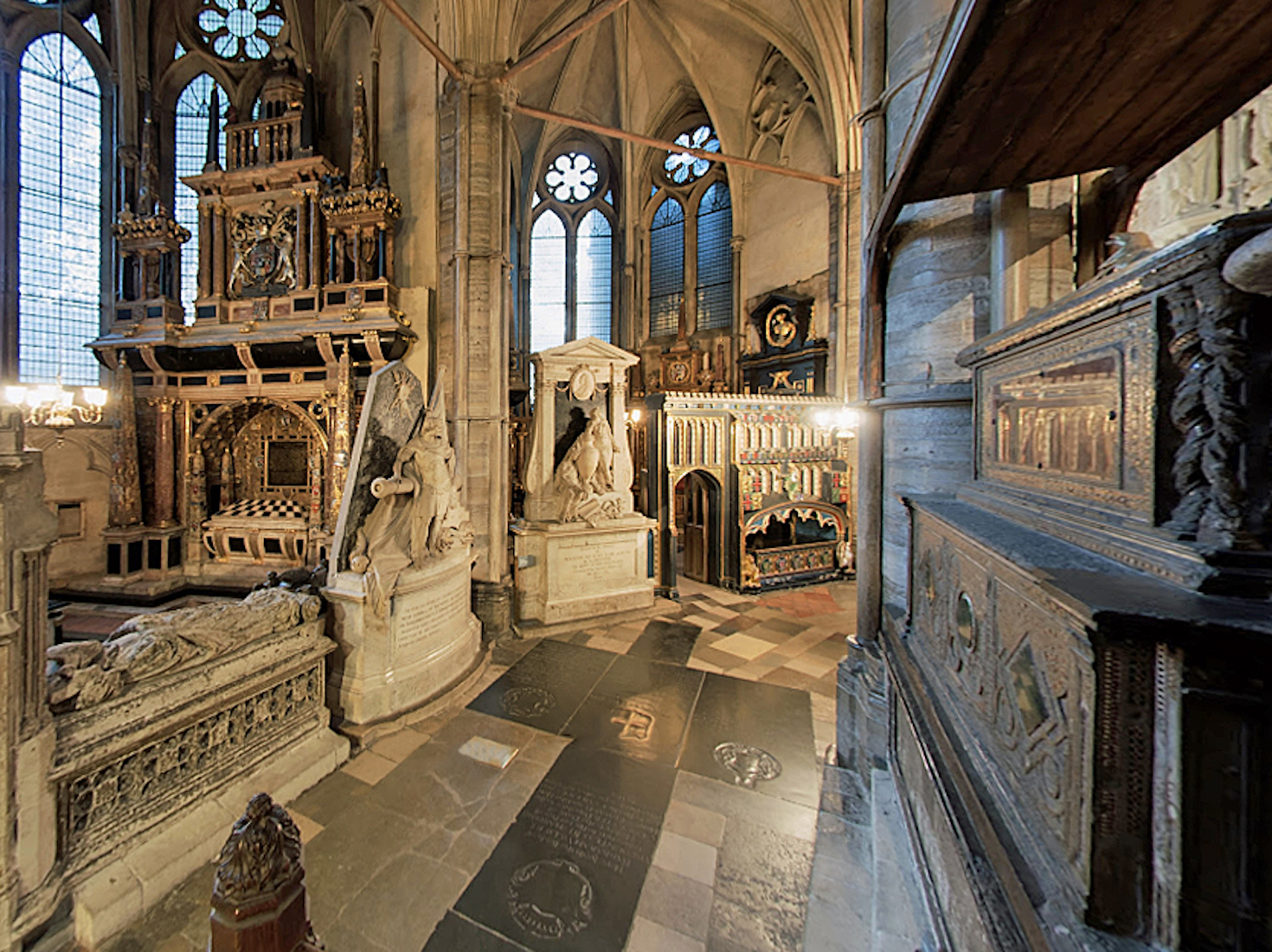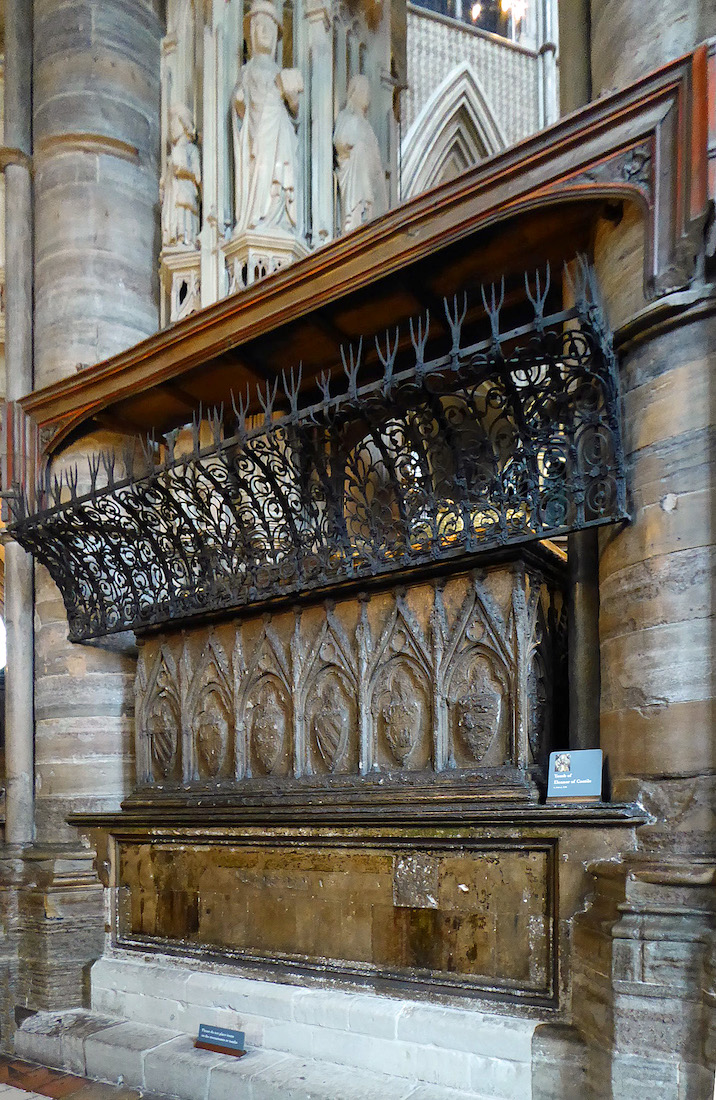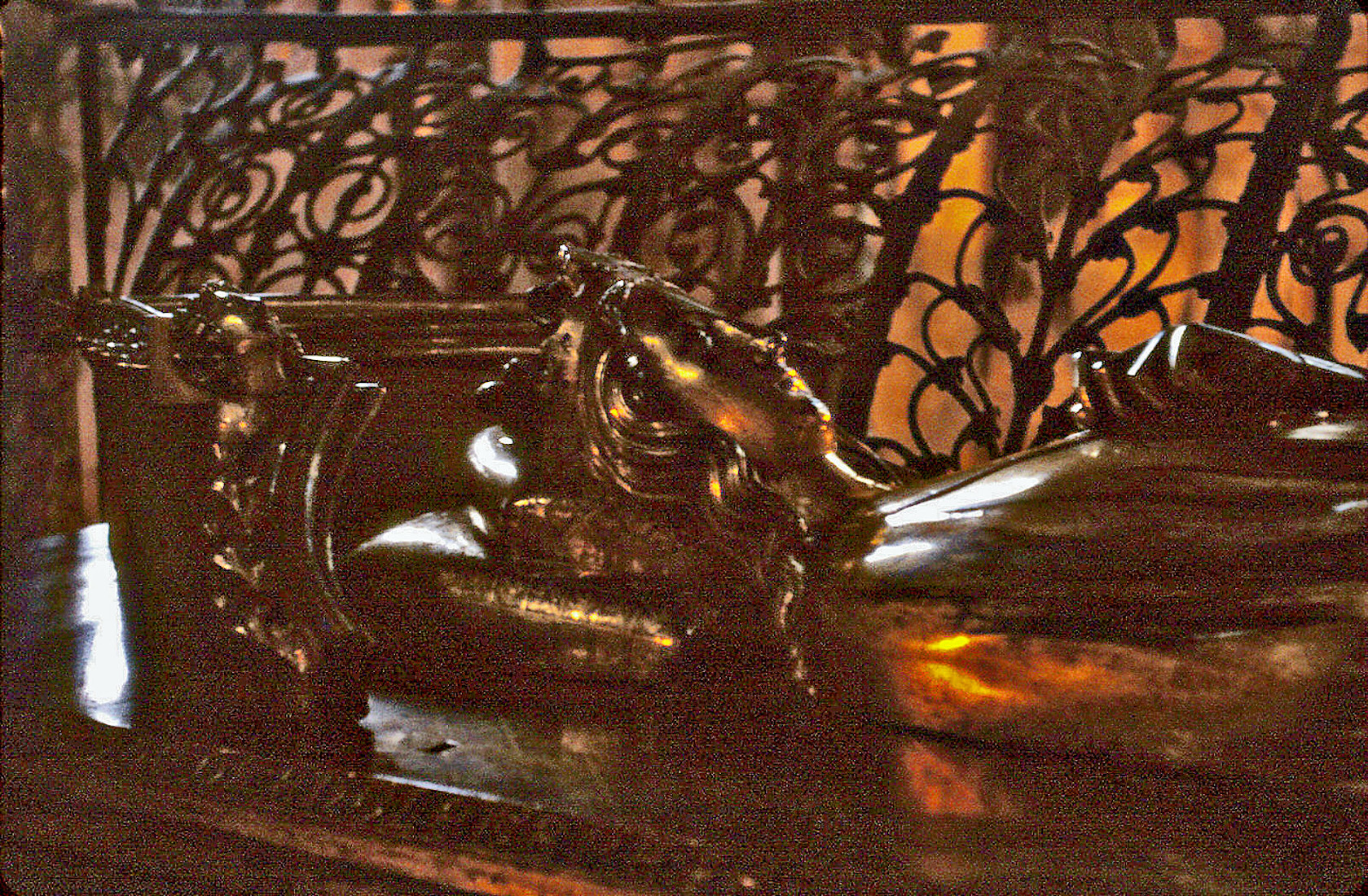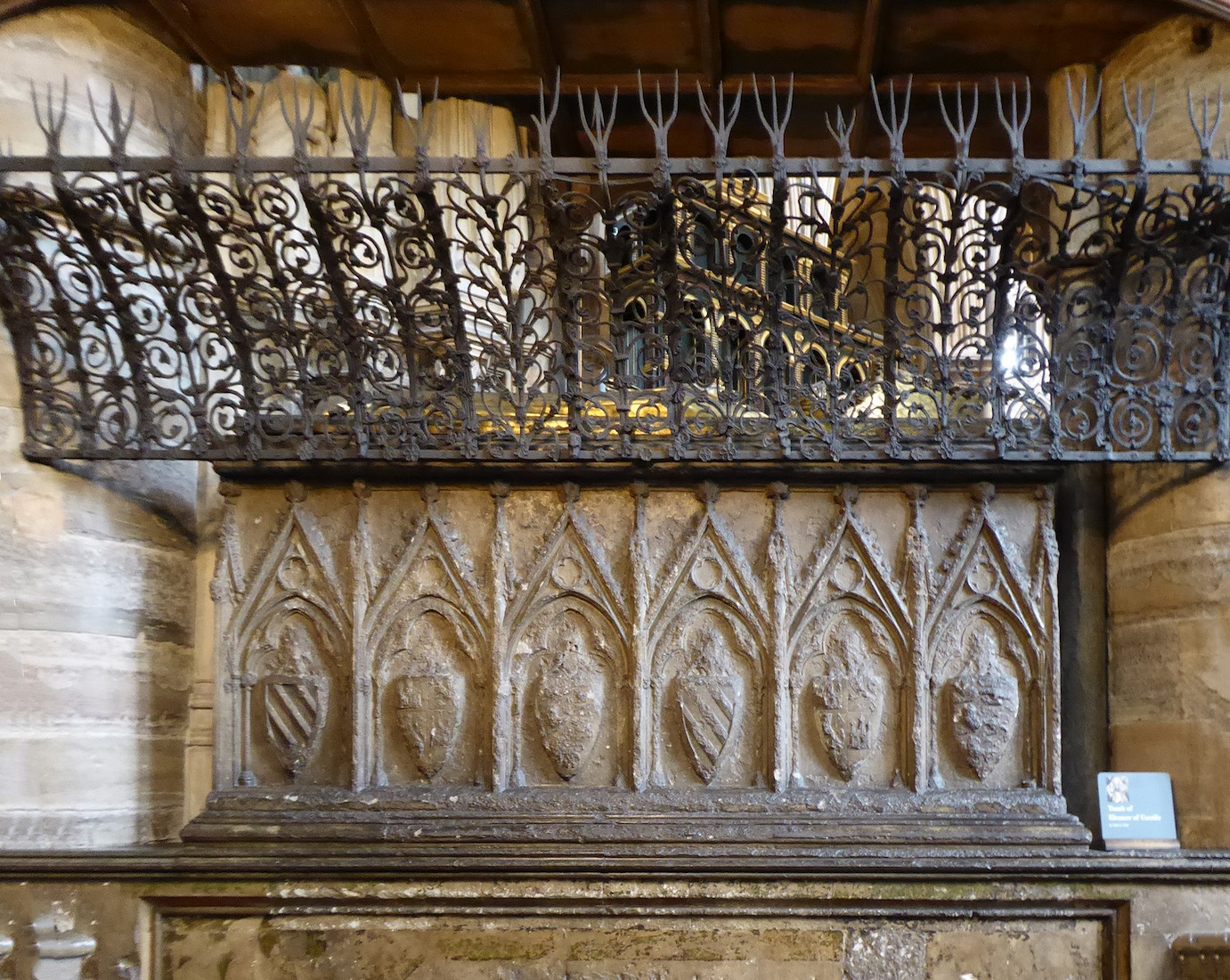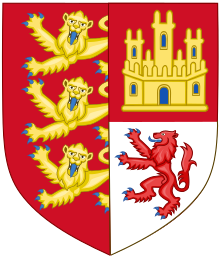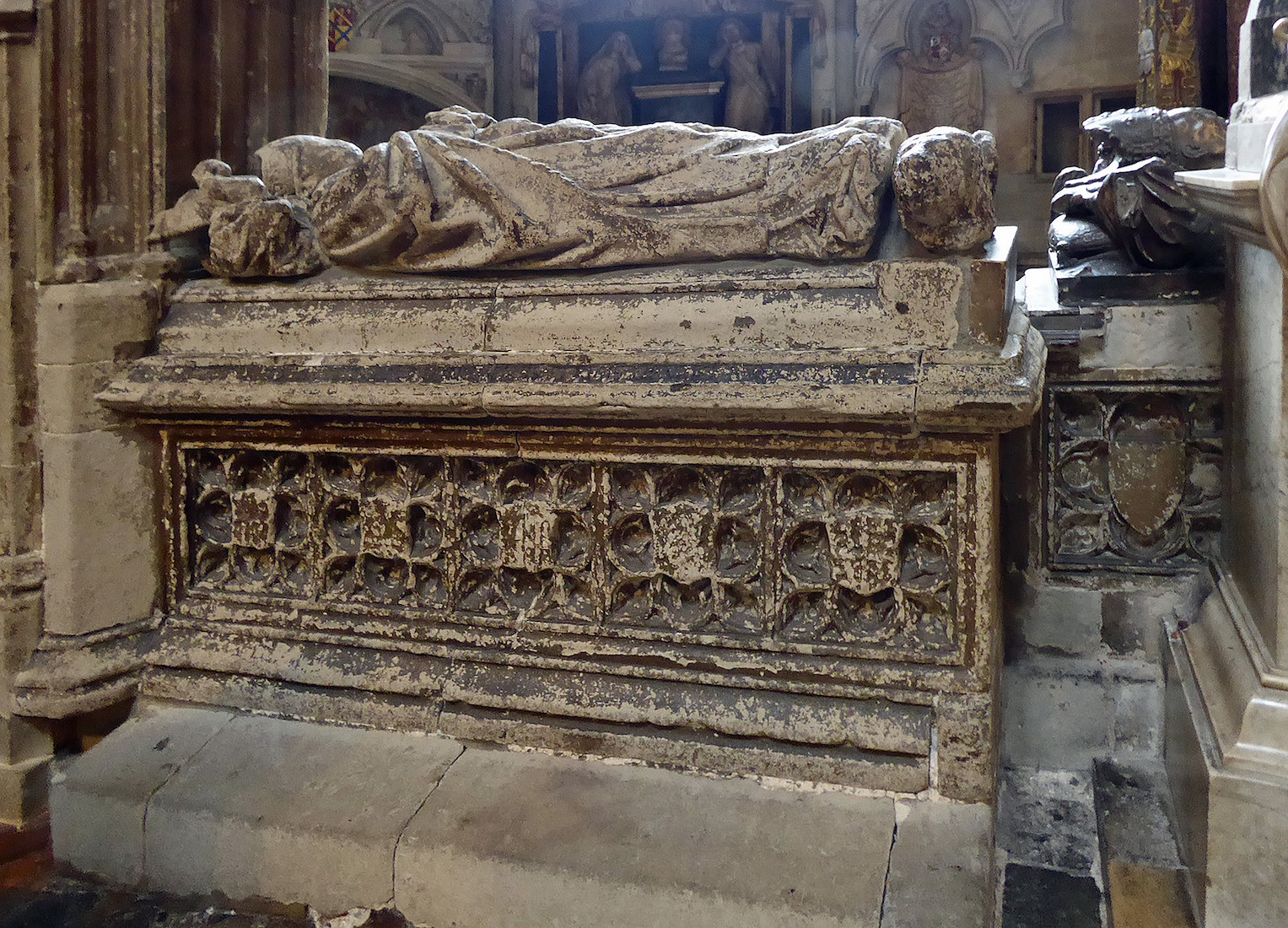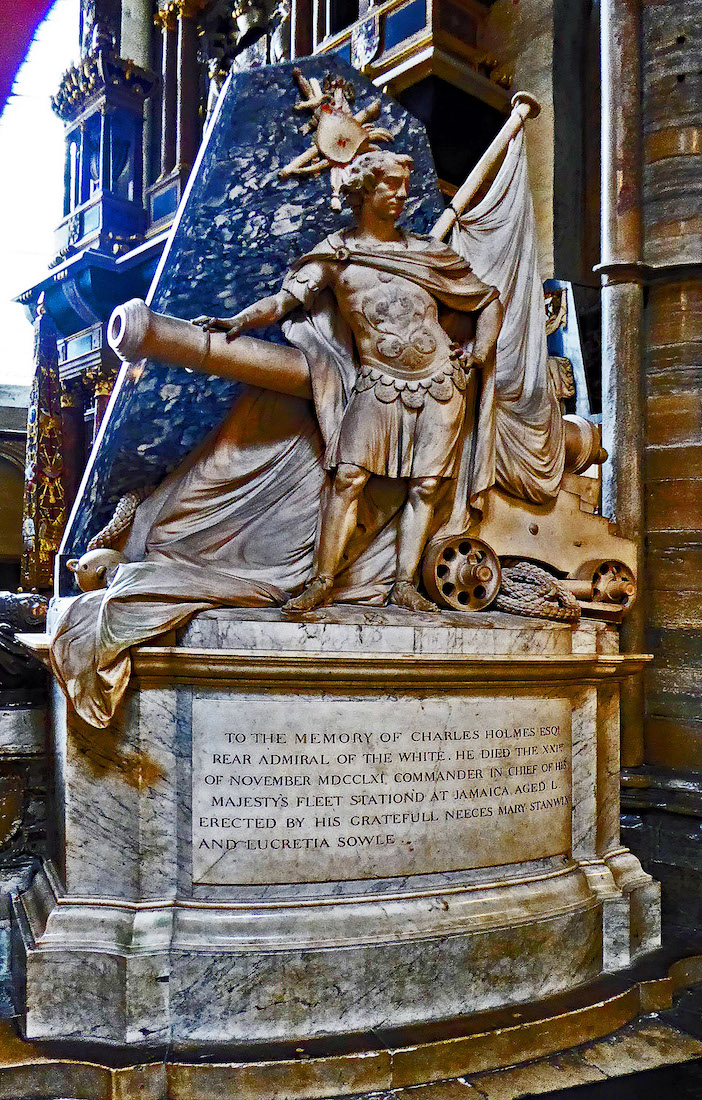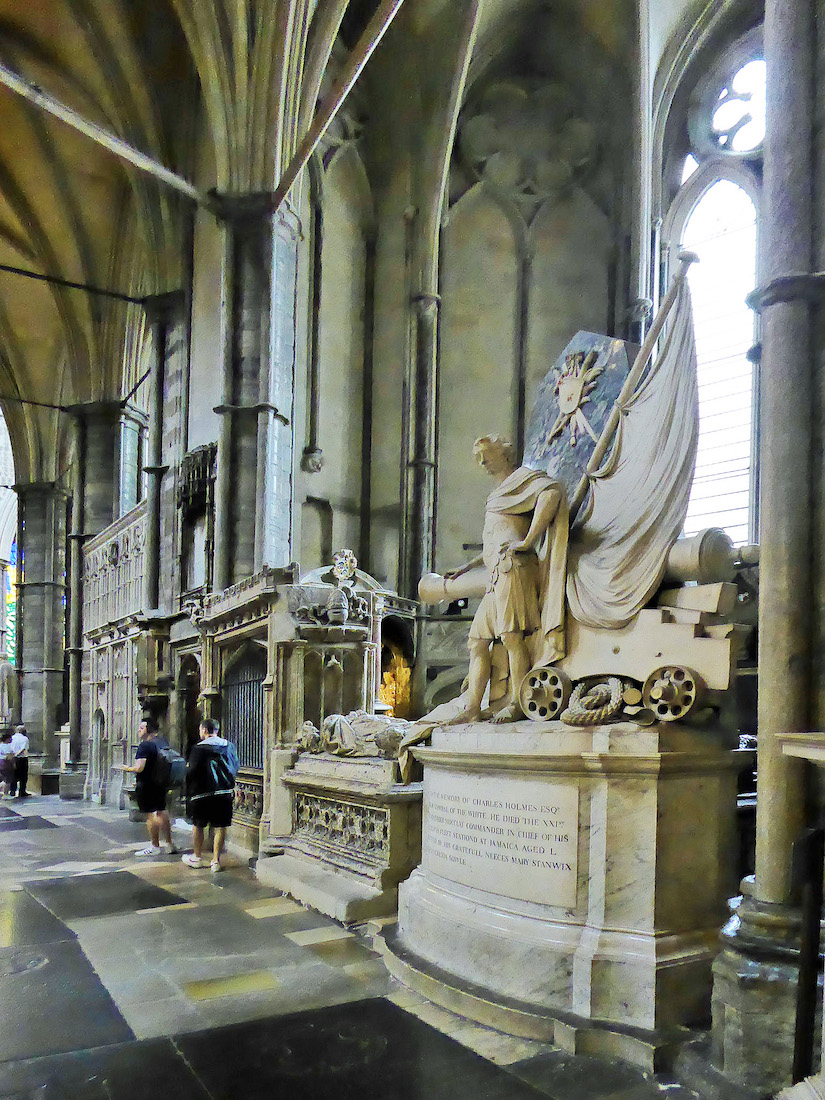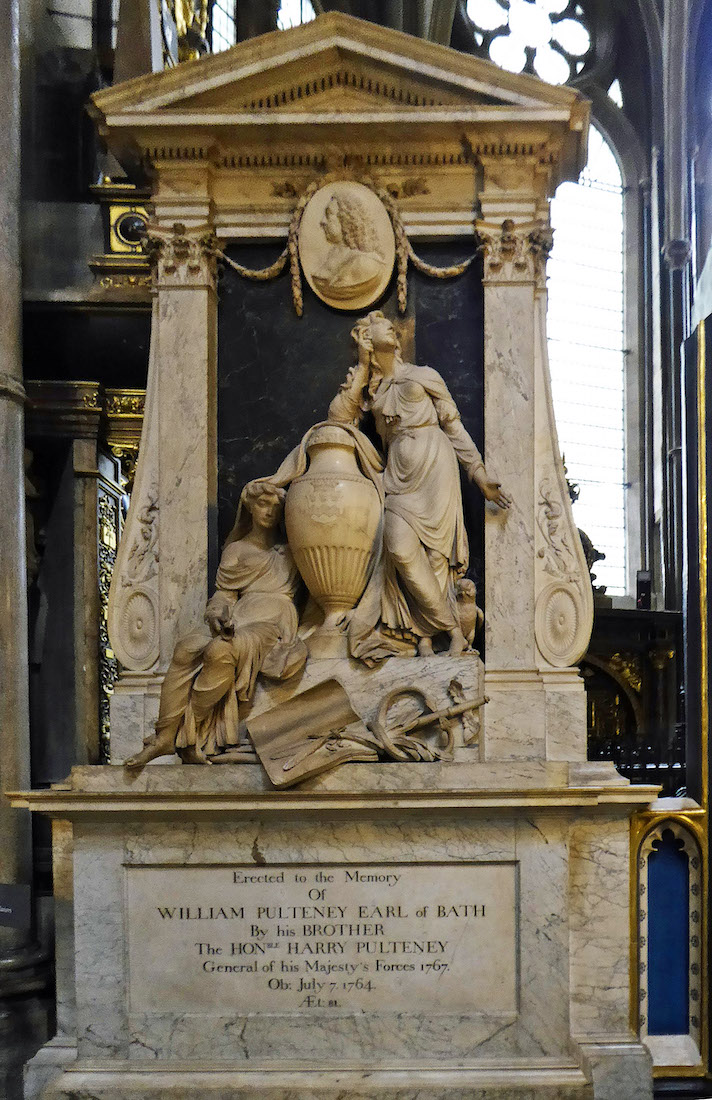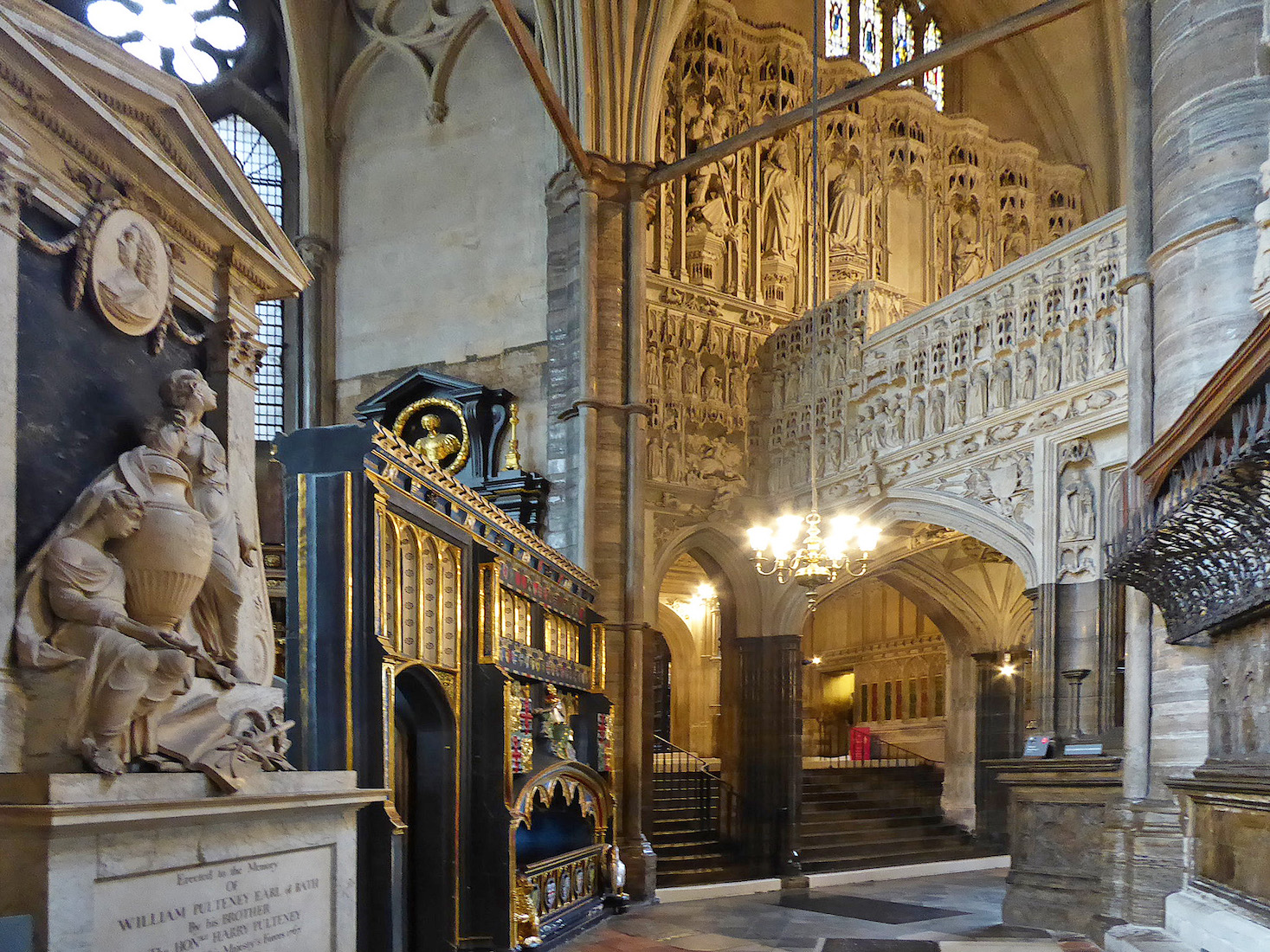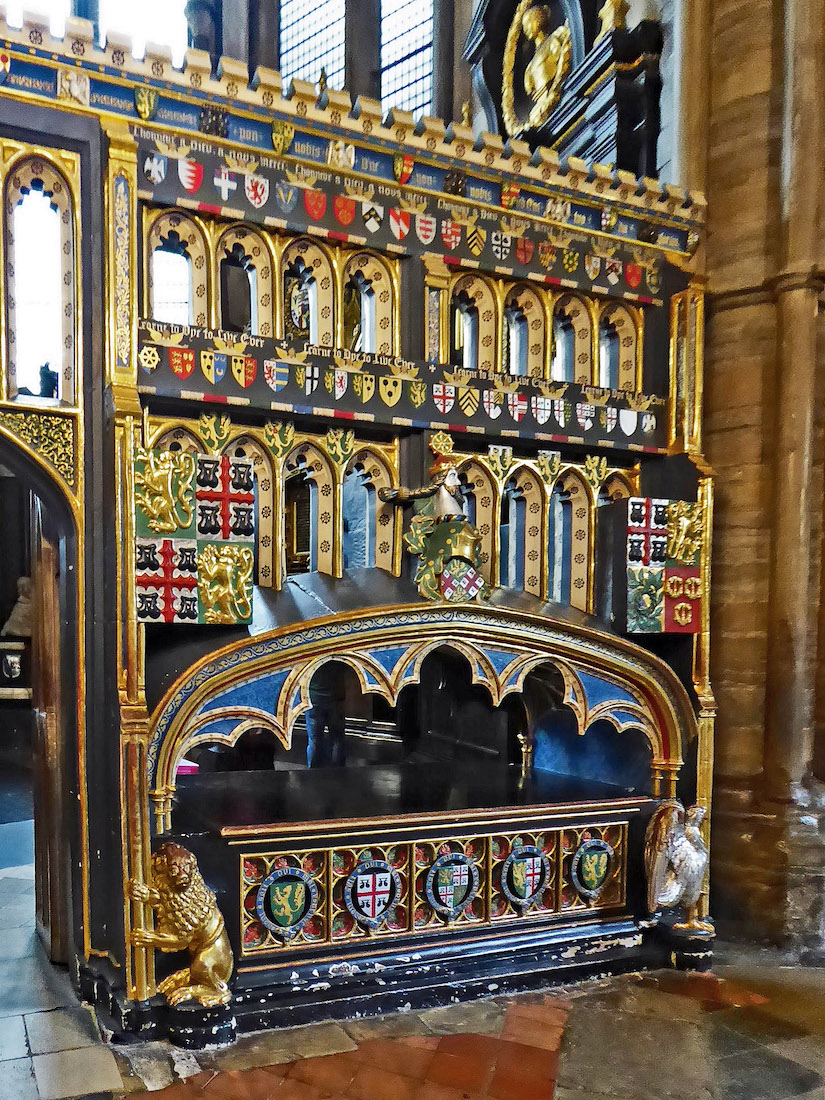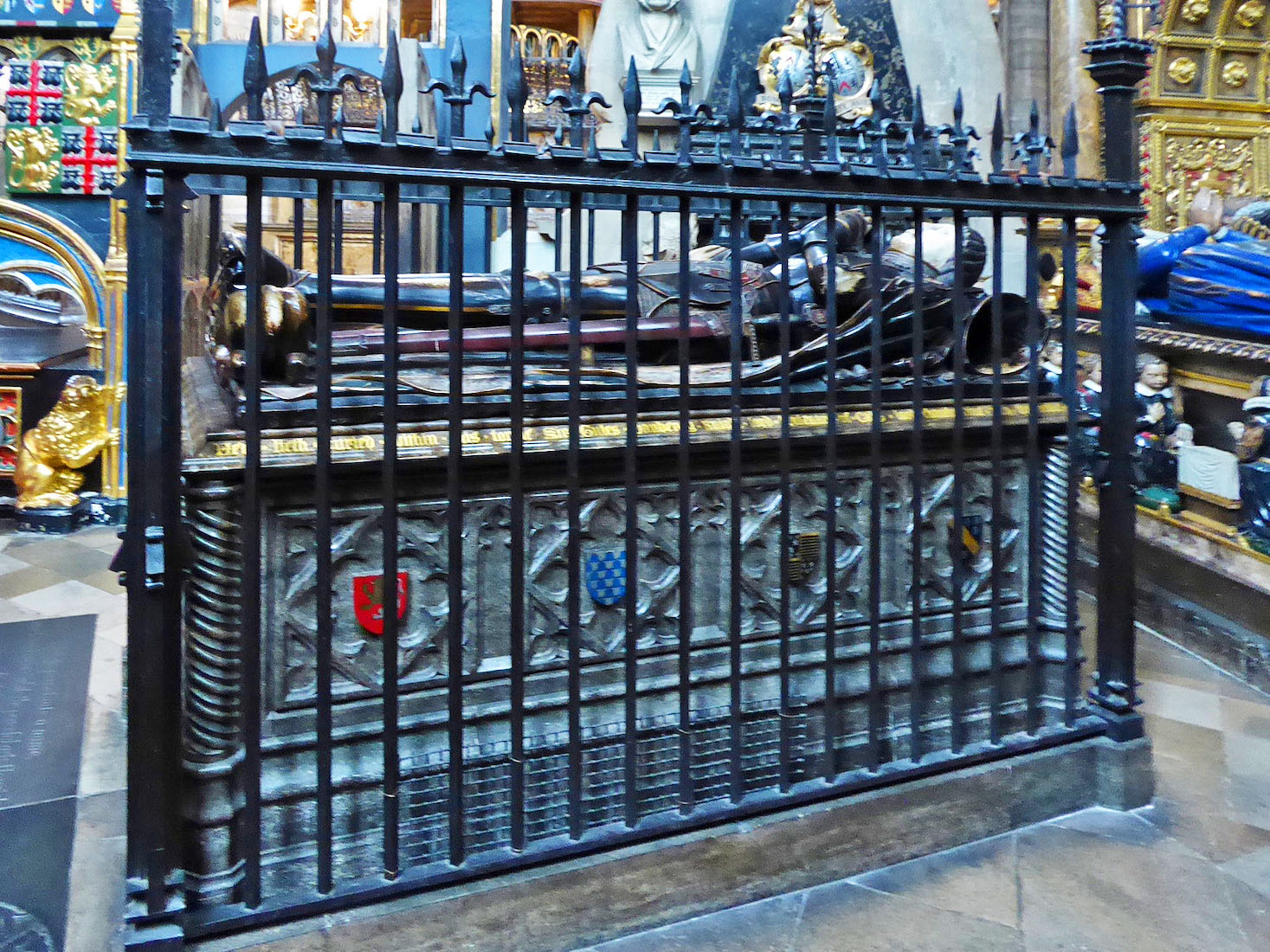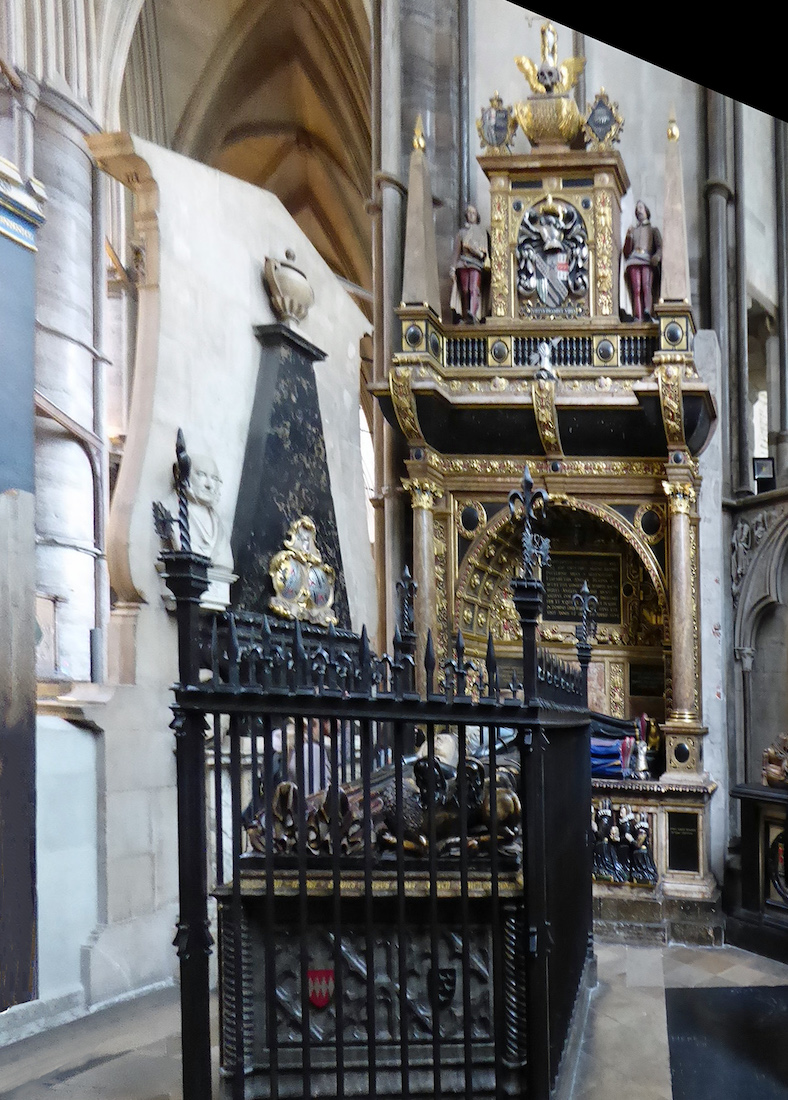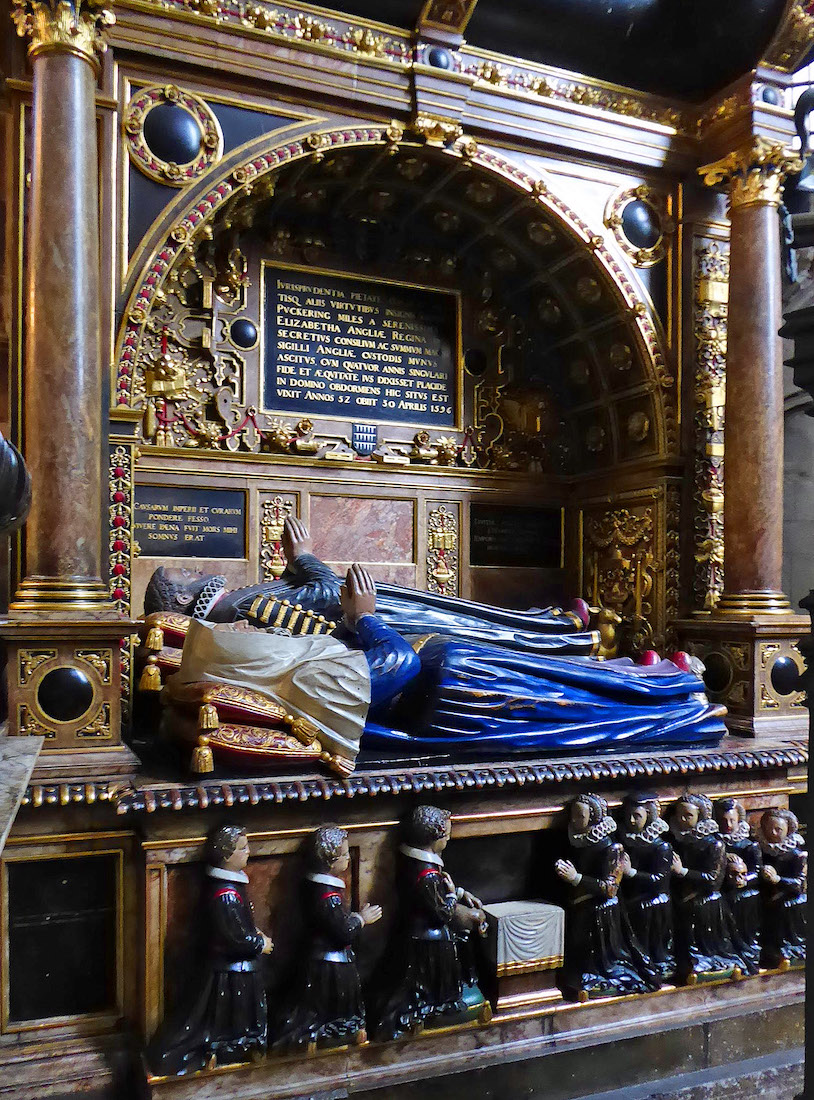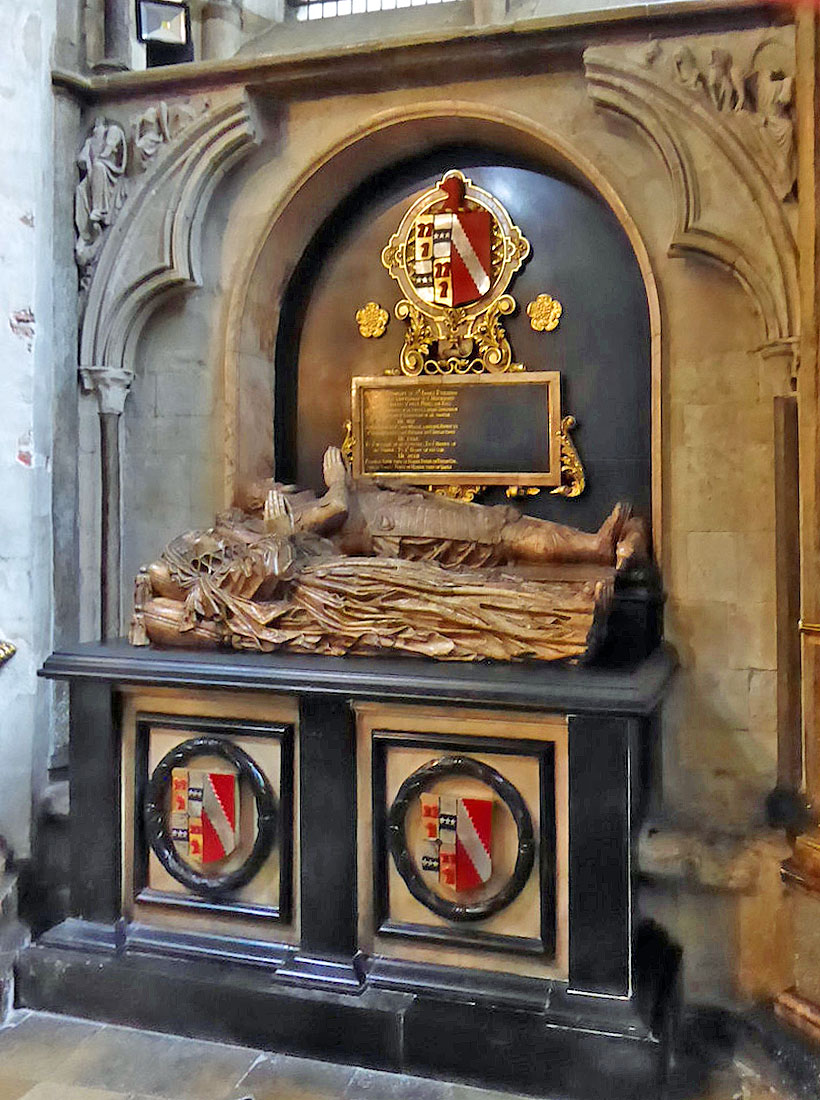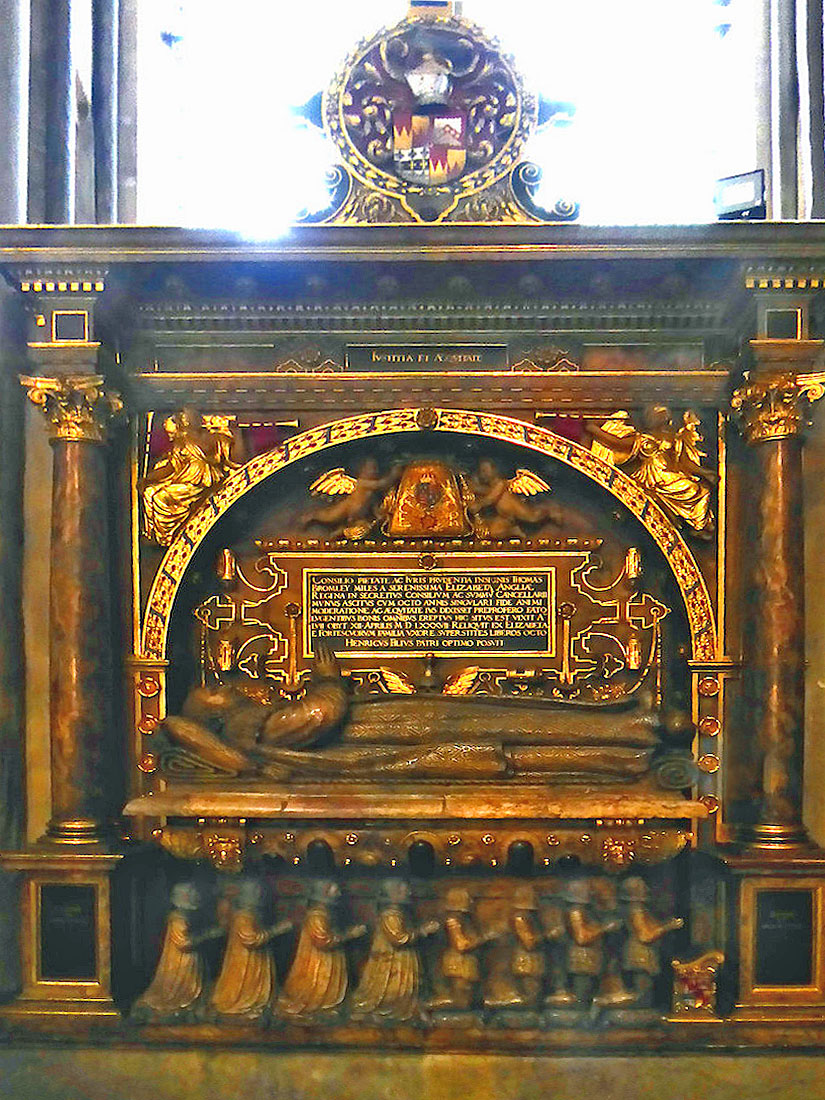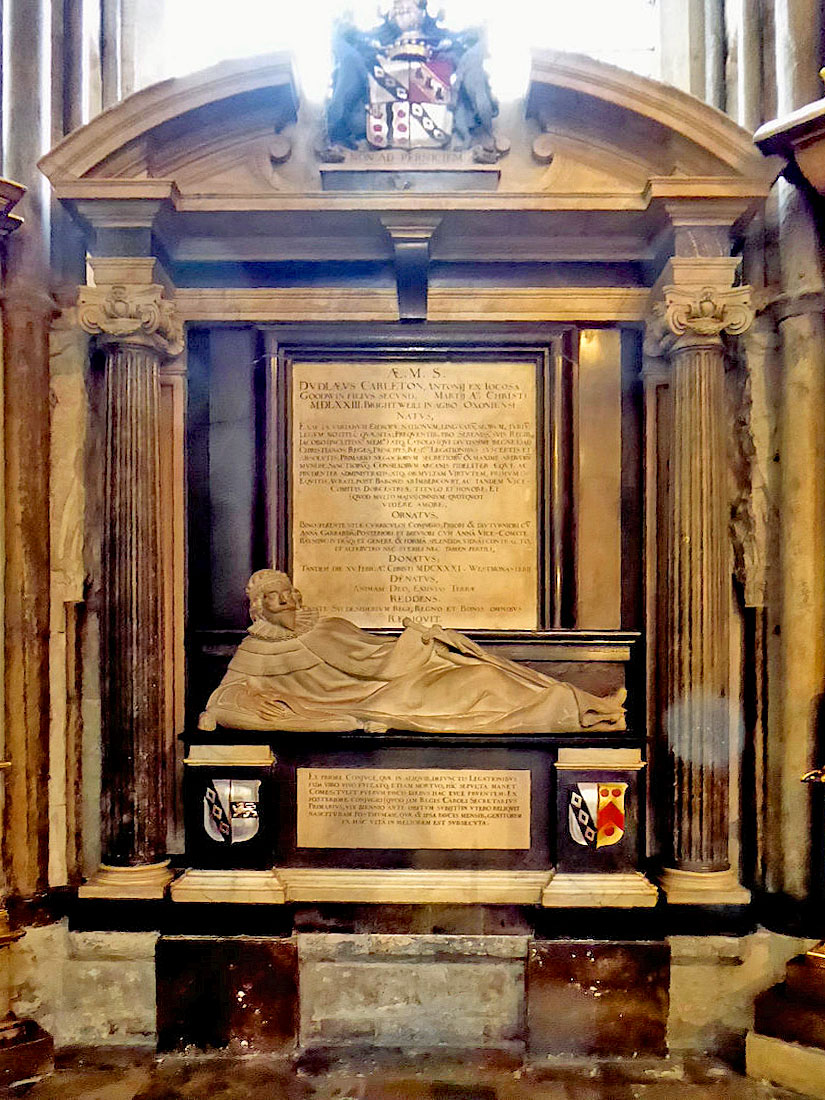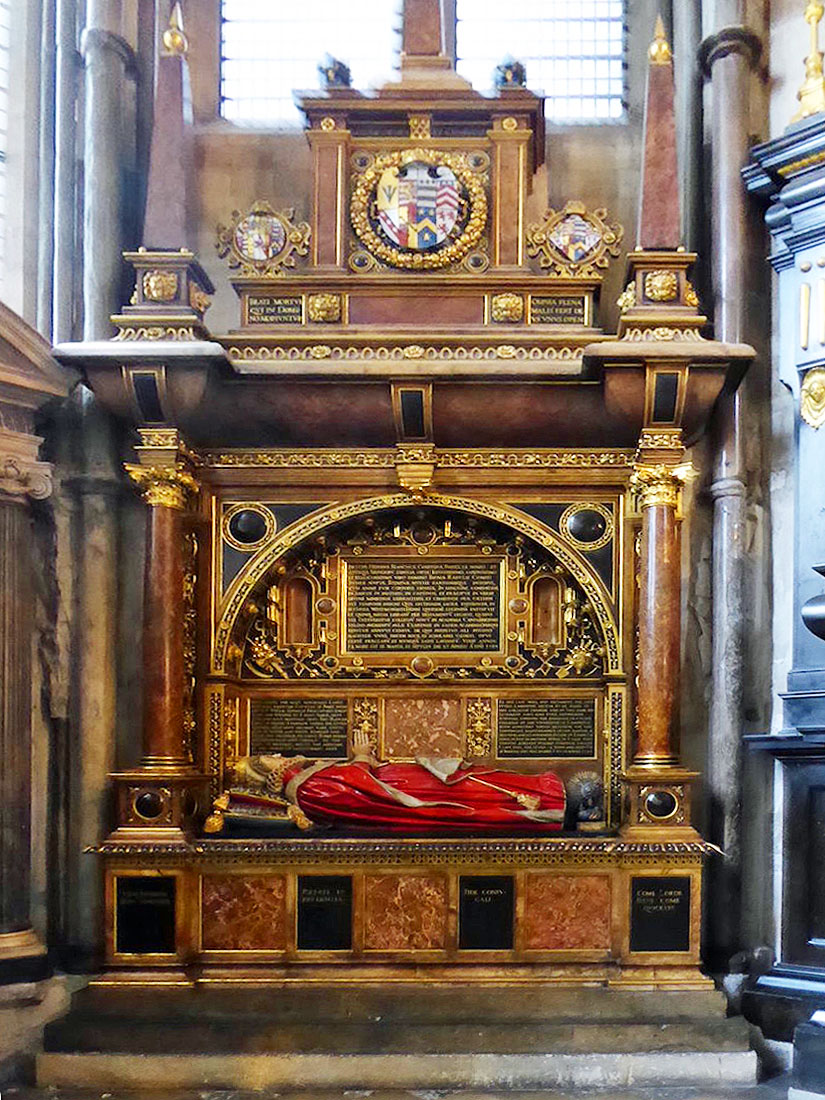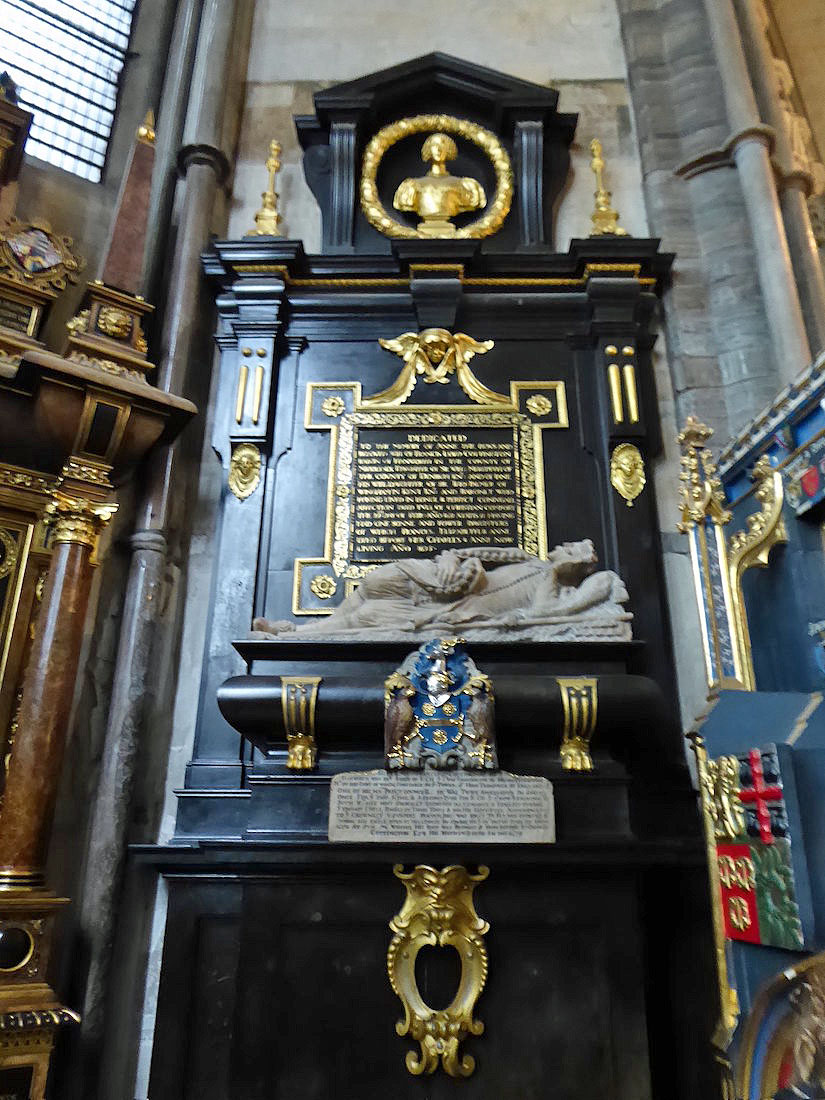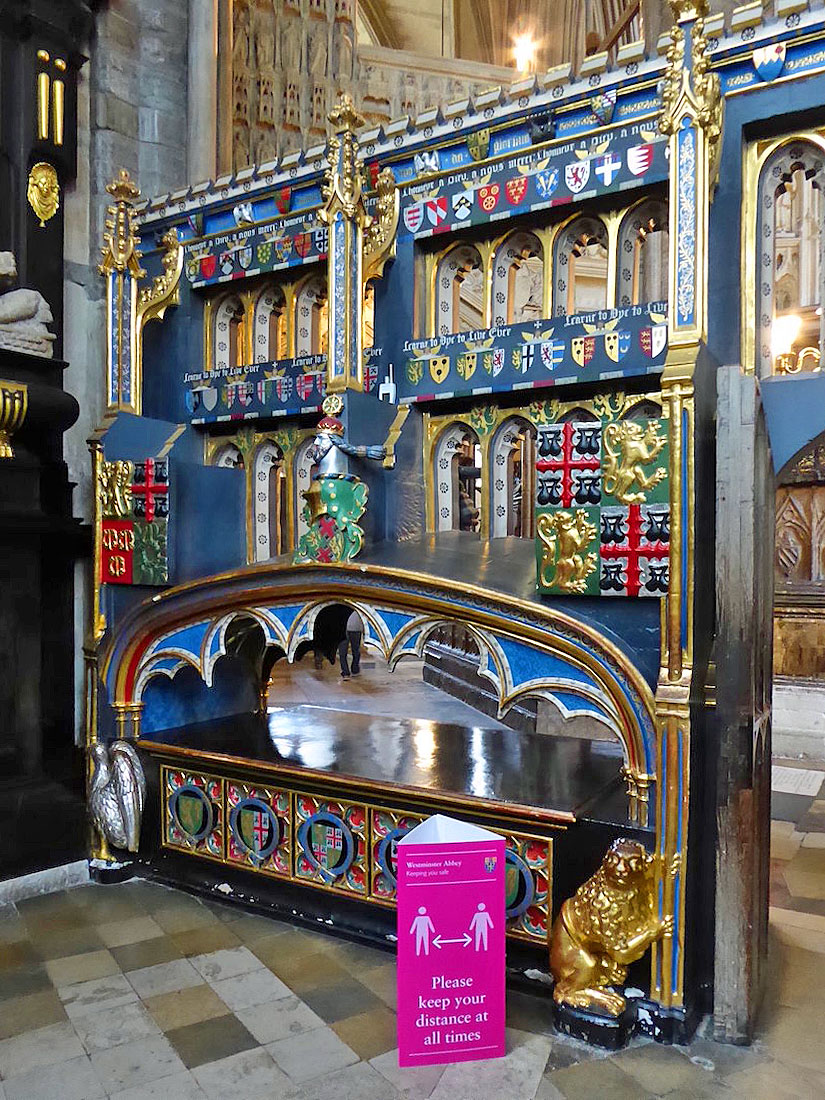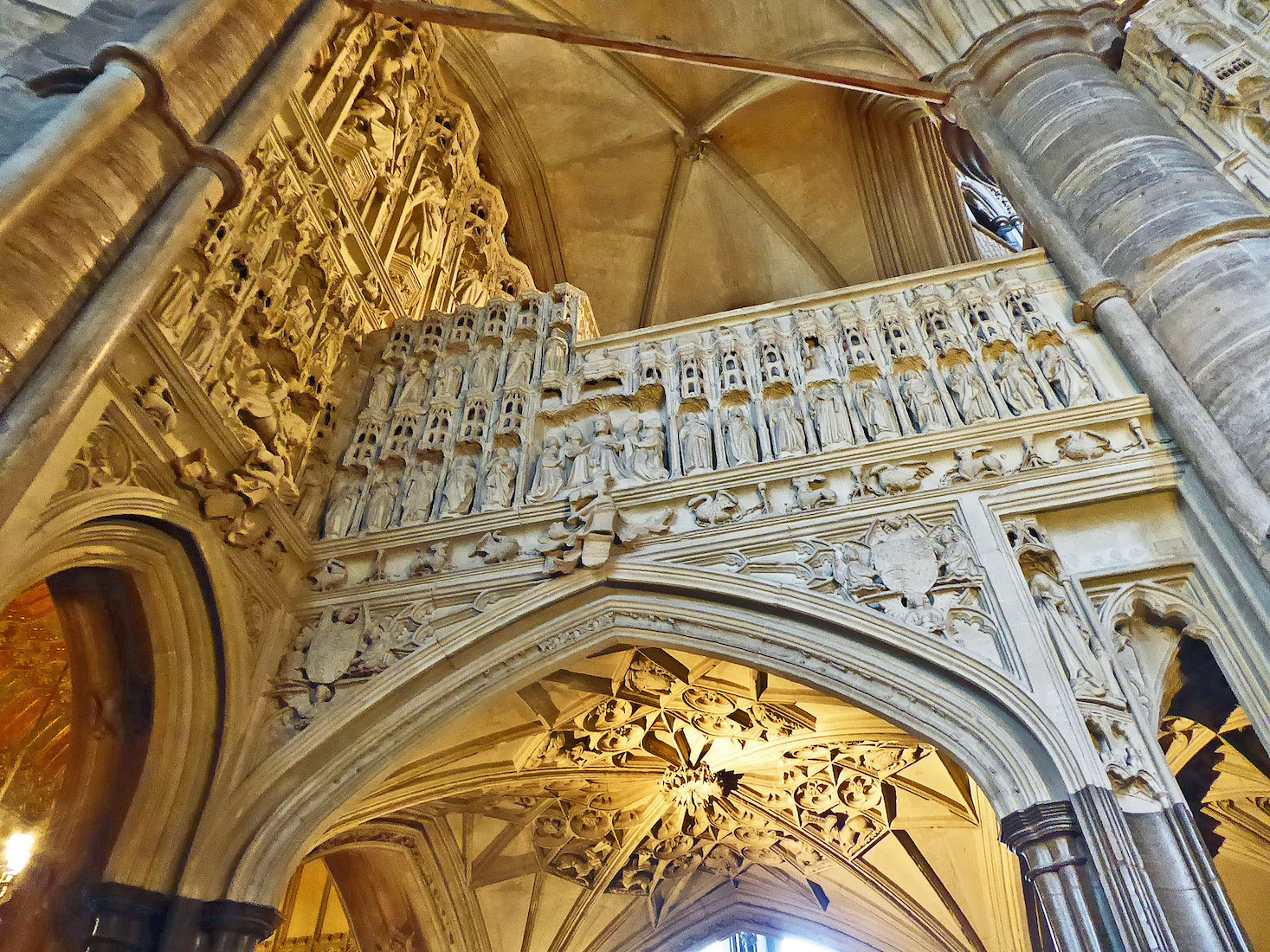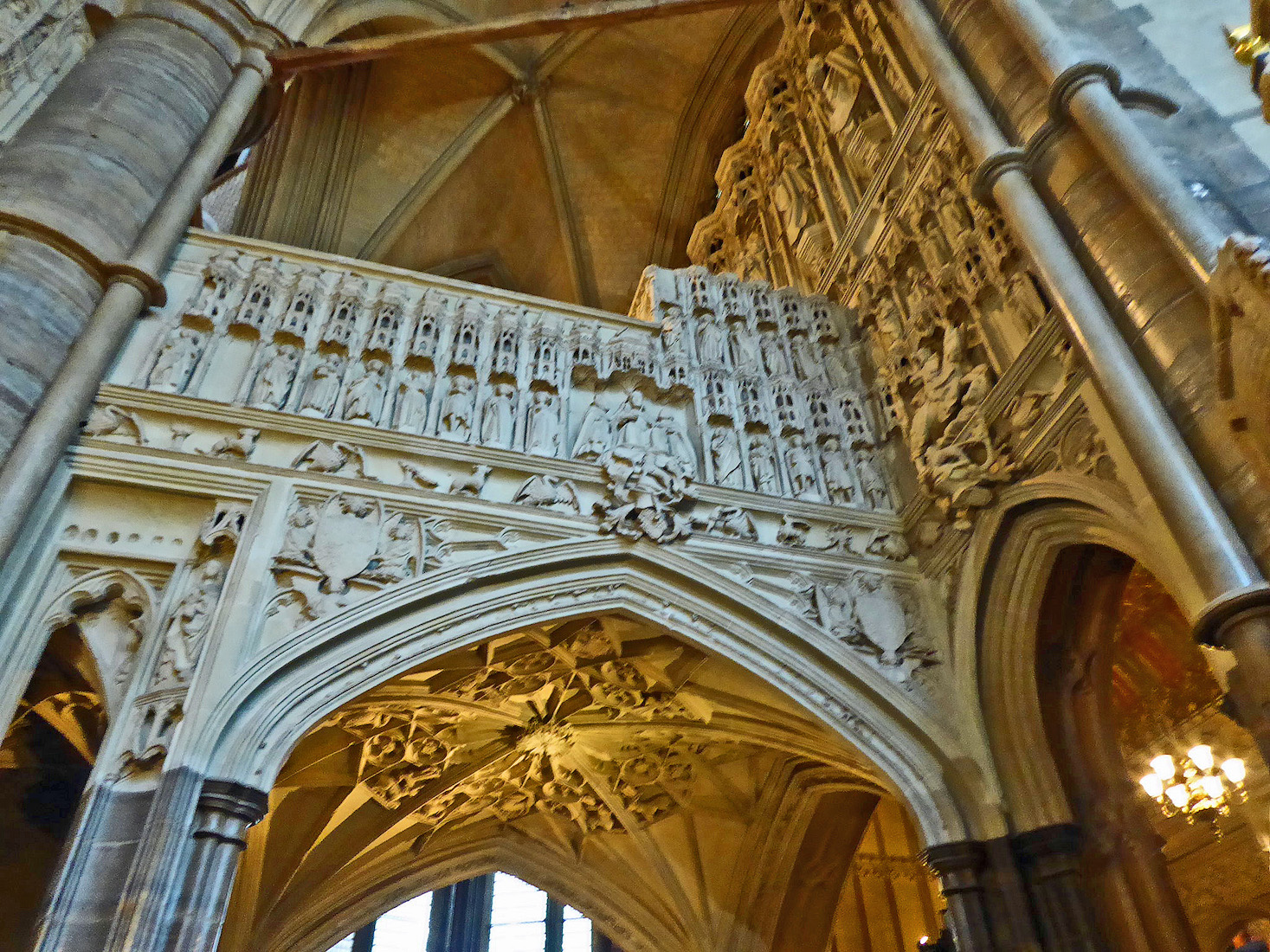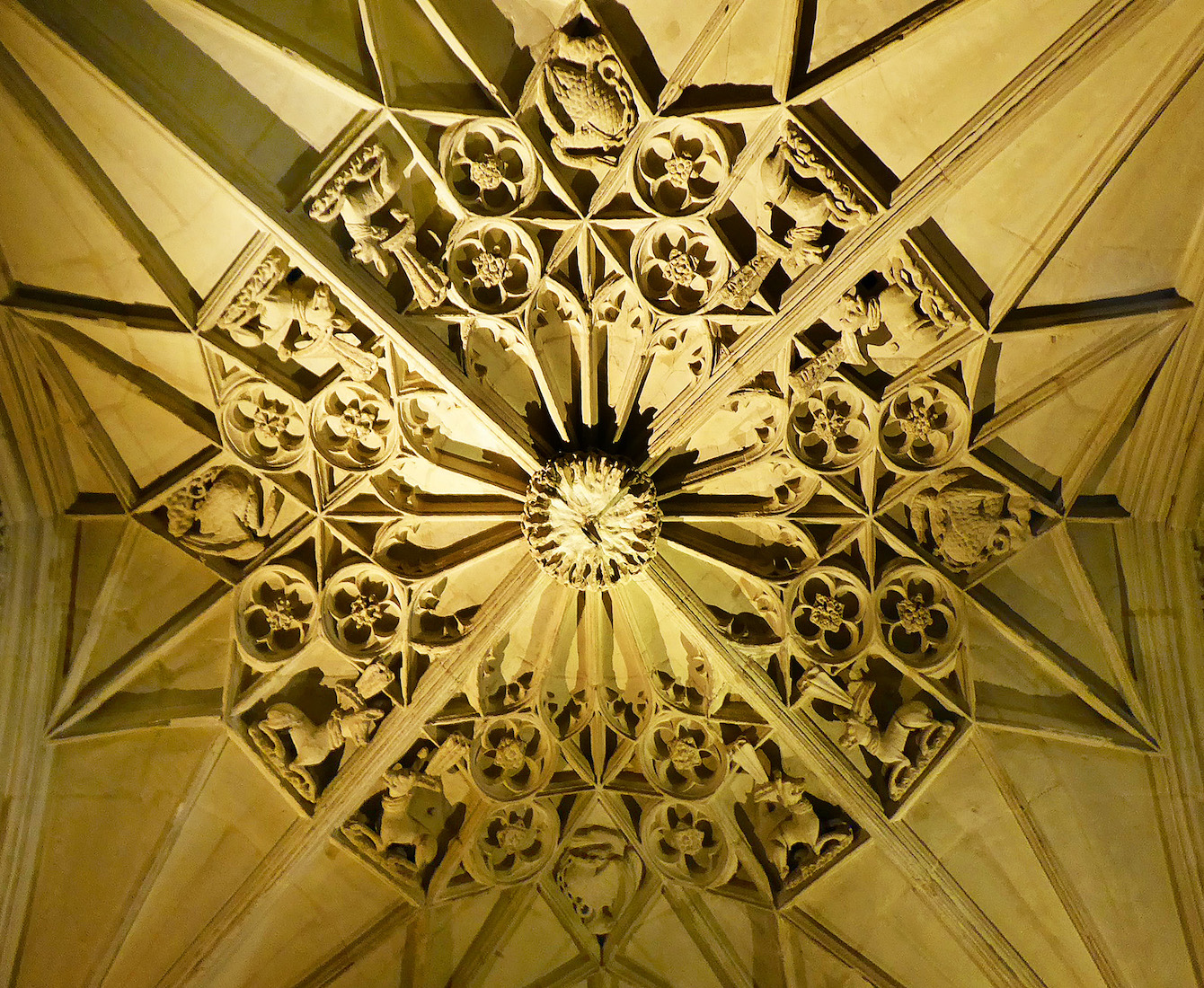F21. STEPS UP BY THE TOMB OF KING EDWARD I AMT AMT
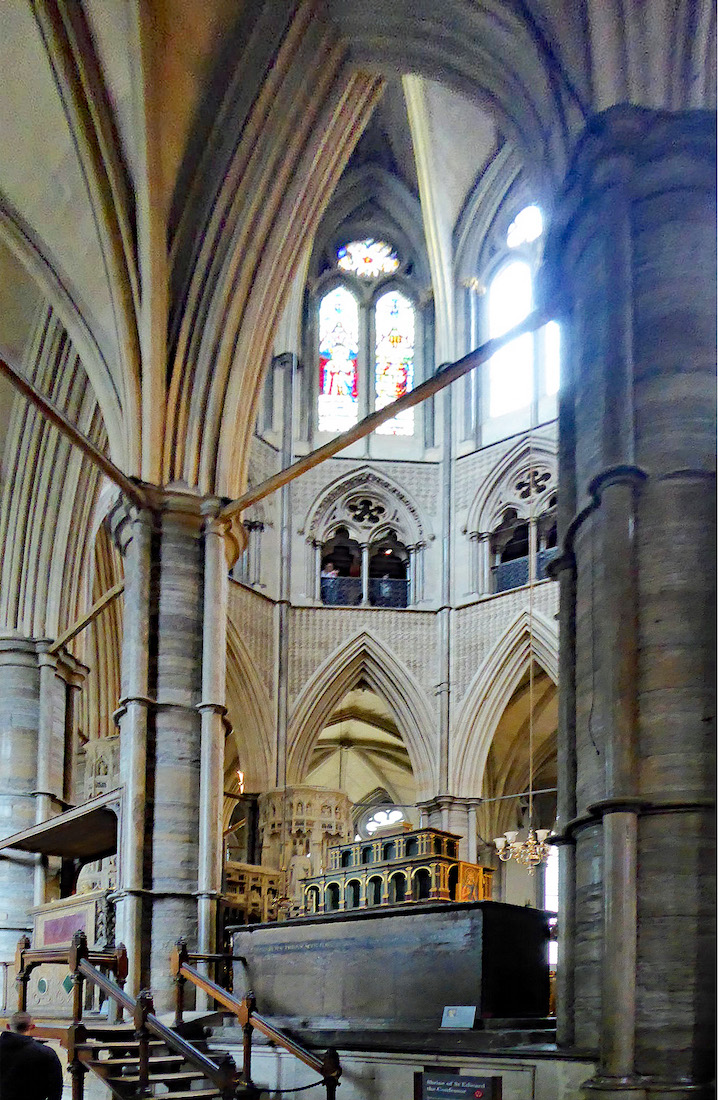

We return to the ambulatory and climb the steps up to St Edward’s Chapel. At the top of the stairs is the tomb of another Edward, Edward I (1239 – 1307). The severe plainness of this grim purbeck-marble tomb chest rather matches the severity of the man himself, best remembered for his wars to subjugate Wales and Scotland. INDEX
F22. SHRINE OF KING EDWARD THE CONFESSOR GSV AMT
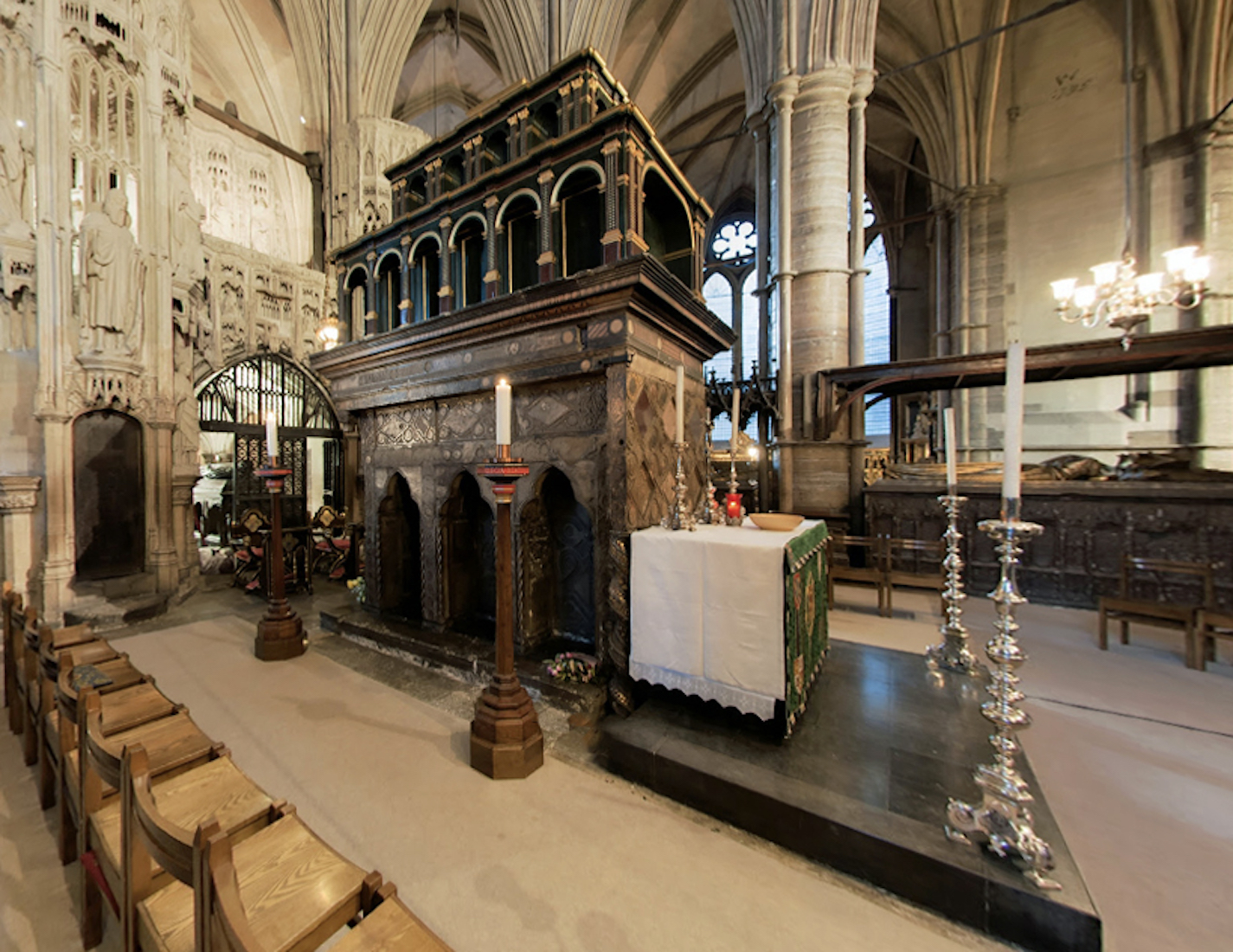
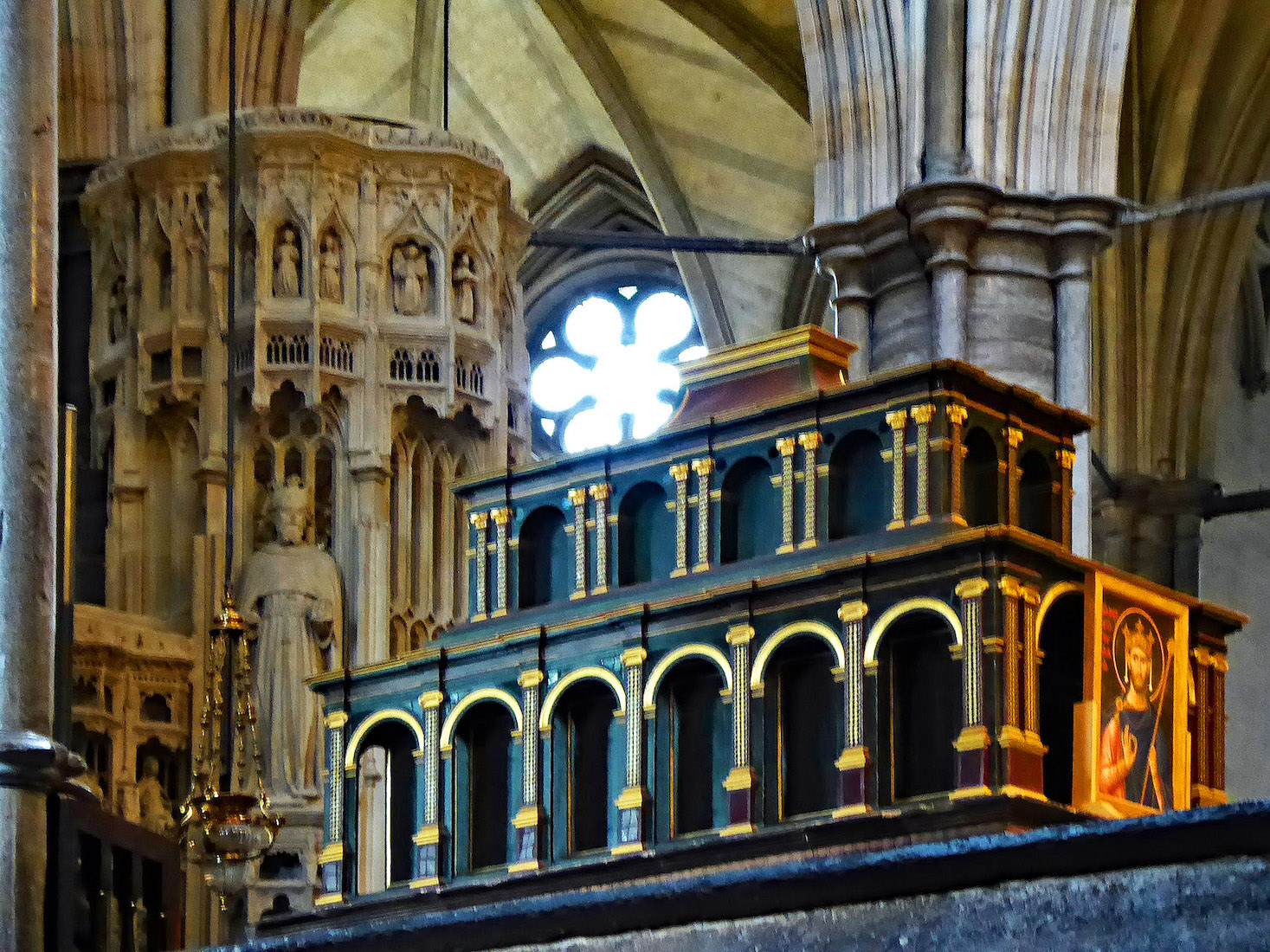
The shrine of St Edward the Confessor (c1002 – 1066) is at the centre of the chapel dedicated to him. Edward established his new Palace of Westminster on the banks of the Thames, and then undertook to re-endow and greatly enlarge a Benedictine monastery which stood nearby. He built a large stone church dedicated to St Peter the Apostle, which became known as the ‘west minster’ to distinguish it from St Paul’s in the City of London. Edward’s 11th-century monastery stood for some two hundred years until 1245 when King Henry III began building a much grander Abbey in honour of St Edward, to whom he was especially devoted.
F23. HIGH APSE WINDOWS AND CHANTRY CHAPEL GSV AMT GSV
Tucked in behind the Shrine of St Edward is the chantry chape of Henry Vl, built between 1437 and1450. It is ornately carved with figures of kings and saints. Here, prayers were said for the soul of the king, best remembered for his victory at Agincourt on St Crispin’s. The surrounding arches soar up to the apse windows.
F24. VIEW FROM TOP OF STEPS AMT
We leave the Chapel of St Edward the Confessor and stand at the top of the steps. To our immediate right is another tomb, the tomb of Henry III, and in fact, there are more tombs around the corner. At left we can see over Ruthall’s tomb into the Chapel of St John the Baptist. Then, past two large monuments is the Chapel of St Paul. We descend to the ambulatory.
F25. TOMB OF HENRY III AMT WA
We stand before the tomb of King Henry III (d.1272) on the North side of the Confessor's chapel. Henry III began the building of the present Gothic abbey church and this area belongs to his reign. This side shows off the delicate gilded Cosmati mosaic decoration, though sadly the lower, more accessible areas have been picked clean by souvenir hunters over the centuries. The striking gilded-bronze effigy of Henry by William Torel is placed too high to be seen from the aisle, but can be seen from the chapel above.
F26. QUEEN ELEANOR’S TOMB AMT AMT
Along from the tomb of Henry III is Queen Eleanor’s tomb. Eleanor of Castile (1241 – 1290) was Queen of England as the first wife of Edward I, whom she married as part of a political deal to affirm English sovereignty over Gascony. The marriage was known to be particularly close, and Eleanor travelled extensively with her husband. She was with him on the Ninth Crusade, when he was wounded at Acre, but the popular story of her saving his life by sucking out the poison has long been discredited. When she died, at Harby near Lincoln, her grieving husband famously ordered a stone cross to be erected at each stopping-place on the journey to London, ending at Charing Cross.
F27. TOMB OF QUEEN ELEANOR AMT
Eleanor’s tomb consists of a marble chest with carved mouldings and shields (originally painted) of the arms of England, Castile, and Ponthieu. The chest is surmounted by William Torel's superb gilt-bronze effigy, showing Eleanor in the same pose as the image on her great seal. At right is the coat of arms of Eleanor of Castile as Queen consort of England.
F28. NORTH AMBULATORY, RUTHALL TOMB AMT
The Ruthall tomb separates the St John the Baptist Chapel from the ambulatory. The stone tomb, with a rather decayed effigy, is to Thomas Ruthall, bishop of Durham. The effigy is dressed in Mass vestments with angels at his head and a lion at his feet. At the west end are the remains of the canopy which was once over the tomb, on which is an heraldic ‘achievement’ with the date 1524. Shields of arms are shown in panels on both sides including ‘a cross patee between four birds, in chief two roses’ for Ruthall. The Latin inscription is barely legible and now incomplete but can be translated: Here lies Thomas Ruthall, bishop of Durham and secretary to King Henry VII, who died...
F29. HOLMES MEMORIAL AMT AMT
Next to the Ruthall tomb is the Holmes monument. This is a large monument of grey and white marble to Rear Admiral Charles Holmes (d. 1761). It shows the admiral in Roman armour (one of the last monuments in the Abbey to depict an English seaman in this way) leaning against a large cannon mounted on a sea-carriage. Behind are naval trophies including an anchor and coiled rope and a flag.
F30. PULTENEY MONUMENT AMT
the Islip Chapel where Pulteney and his family are buried. The monument, by Joseph Wilton, has a figure representing Wisdom standing by a large urn under a portrait medallion of Pulteney.
F31. NORTH AMBULATORY AND HENRY V CHANTRY AMT
Immediately next to the Pulteney monument is the smart façade of St Paul’s Chapel which we look at next. Notice that we are just opposite the tomb of Queen Eleanor. In front of us is a wide flight of stairs leading up to the Lady Chapel. And above is this curious construction whereby the ambulatory curves around, passing under the Henry V Chantry Chapel.
F32. BOURCHIER TOMB AMT
But first, the colourful and ornate tomb of Humphrey Bourchier (or Bourgchier). The purbeck marble altar tomb once had a brass figure on it which has been lost but four engraved shields of arms and his crest of a Saracen's head still remain, together with the inscription plate. The coats of arms include those of Bourgchier - a cross engrailed between four water bougets or leather water carriers – Louvain, Berners, Tilney and Thorpe. The archway at left leads us through to the St Paul’s Chapel.
F33. ST PAUL’S CHAPEL, DAUBENEY TOMB AMT
We enter St Paul’s Chapel to find a tomb in the middle (the Daubeney tomb), surrounded as expected by a ring of tombs and monuments around the walls. From the left we shall find the Puckering tomb; then the Fullarton, Bromley and Carleton tombs under the windows; next the Countess of Sussex tomb; and finally the Cottington Monument and the Bourchet tomb. We look at these more closely ... .
F34. DAUBENEY AND PUCKERING TOMBS AMT AMT
The free-standing tomb is that of Sir Giles Daubeney (1452 – 1507) who was buried where his alabaster effigy lies next to that of his wife. He wears plate armour and his head rests on a large helmet with a holly-tree crest, and his feet on a lion. •• At right is the tomb of Sir John Puckering, Speaker of the House of Commons. This large monument of alabaster and marble was erected by his widow Jane. On the front of the tomb are depicted kneeling figures of three sons and five daughters. One son and one daughter hold skulls, denoting that they died before their parents. It is possible that one of the other sons died young as Thomas is the only son normally mentioned.
F35. FULLARTON AND BROMLEY TOMBS AMT AMT
Next is the Fullerton monument. Sir James Fullerton was buried in the North ambulatory, near the steps leading to Henry VII’s chapel,in 1630/1631 and a monument was later erected for him in the nearby chapel of St Paul.The alabaster effigies of him and his wife lie on an altar tomb. He wears plate armour and lies on a rush mattress, with an otter (his crest) at his feet. Although his wife’s effigy is shown, her burial does not occur in the Abbey register and there is a blank space on the monument for her inscription. Attached to the girdle of her dress is a miniature portrait of her husband. •• The next tomb is for Sir Thomas Bromley (1530 – 1587). He married Elizabeth, daughter of Sir Adrian Fortescue, and she was buried at St Margaret’s Church Westminster in 1602 (she has no monument). Thomas and Elizabeth had four sons and four daughters who appear near the base of the tomb.
F36. CARLETON AND COUNTESS OF SUSSEX TOMBS AMT AMT
Continuing our pilgrimage ... ! Dudley Carleton (1573 – 1632), Viscount Dorchester and his first wife, Anne Garrard, are buried here and have a large marble monument and effigy by sculptor Nicholas Stone. It was erected in 1640. •• to the right is a large monument of marble and various types of alabaster, about 24 feet high, to the memory of Frances Sidney (1531 – 1589), Countess of Sussex, founder of Sidney Sussex College, Cambridge. Her recumbent effigy is dressed in a long red robe, lined with ermine, and she wears a gilded coronet. At her feet is a wooden blue and gold porcupine, the crest of her family. There are two more of these animals on the top of the tomb. During repairs and repainting of the monument in the early 1960s three hundred new quills of wood were made for the porcupines.
F37. COTTINGTON MONUMENT AND BOURCHIER TOMB AMT AMT
So to the final two monuments. •• Francis, Baron Cottington of Hanworth (1579 – 1652) was twice ambassador to Spain. When his wife Anne died in 1634 Francis set up a black marble monument with a bronze bust of her in St Paul’s chapel where she is buried. Later when Francis died, his remains were brought to the Abbey, and an addition was made to the monument, placing an effigy of him in a recumbent position. •• This completes our circuit of this chapel, bringing us back to the (other side of) the Bourchier tomb.
F38. THE CARVING OF THE HENRY V CHANTRY AMT
We return to the North ambulatory. We have been here before, but this time we observe the ornate carving of the Henry V chantry.
F39. NORTH AND SOUTH SIDE CARVING AMT AMT
The Henry V chantry is supported above the ambulatory and the entry to the Lady Chapel. There are elaborate carvings of saints and kings and bishops, and a row of birds and animals! In the first view we can see on the East wall a fine carving of Henry riding into battle.
F40. HENRY V CHAPEL VAULTING AMT
The under side of the overhead chantry is a further delight of carved detail.



